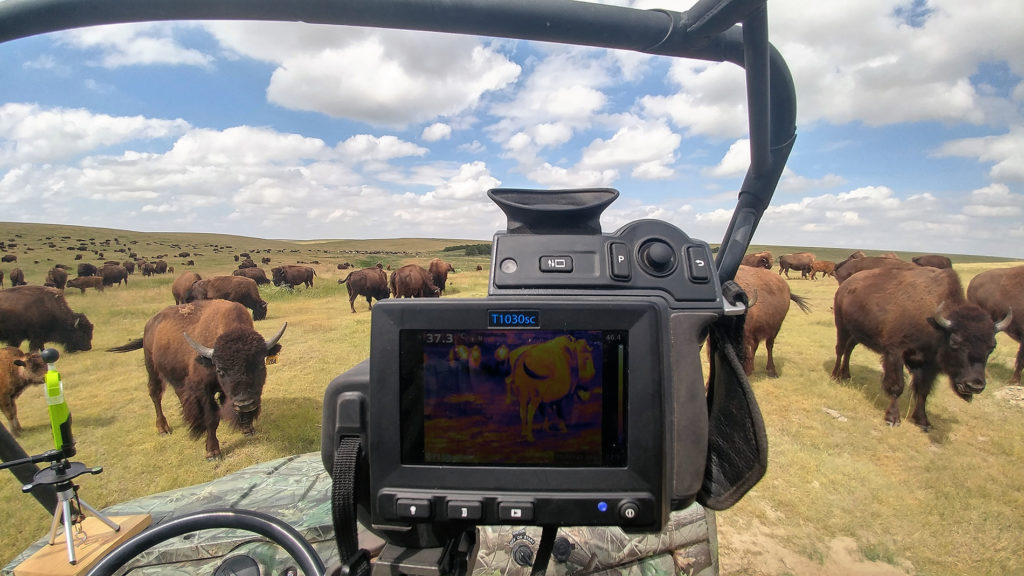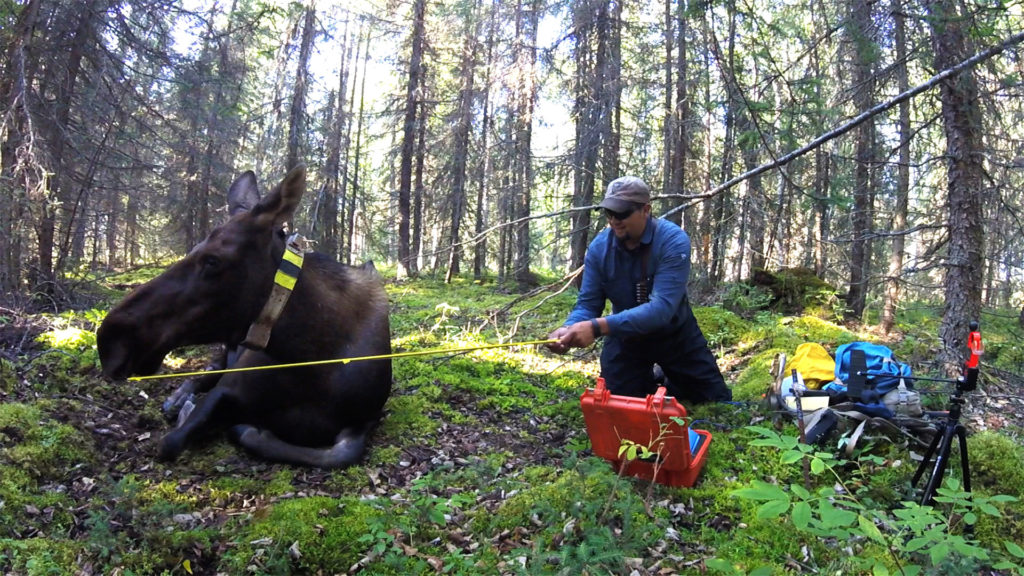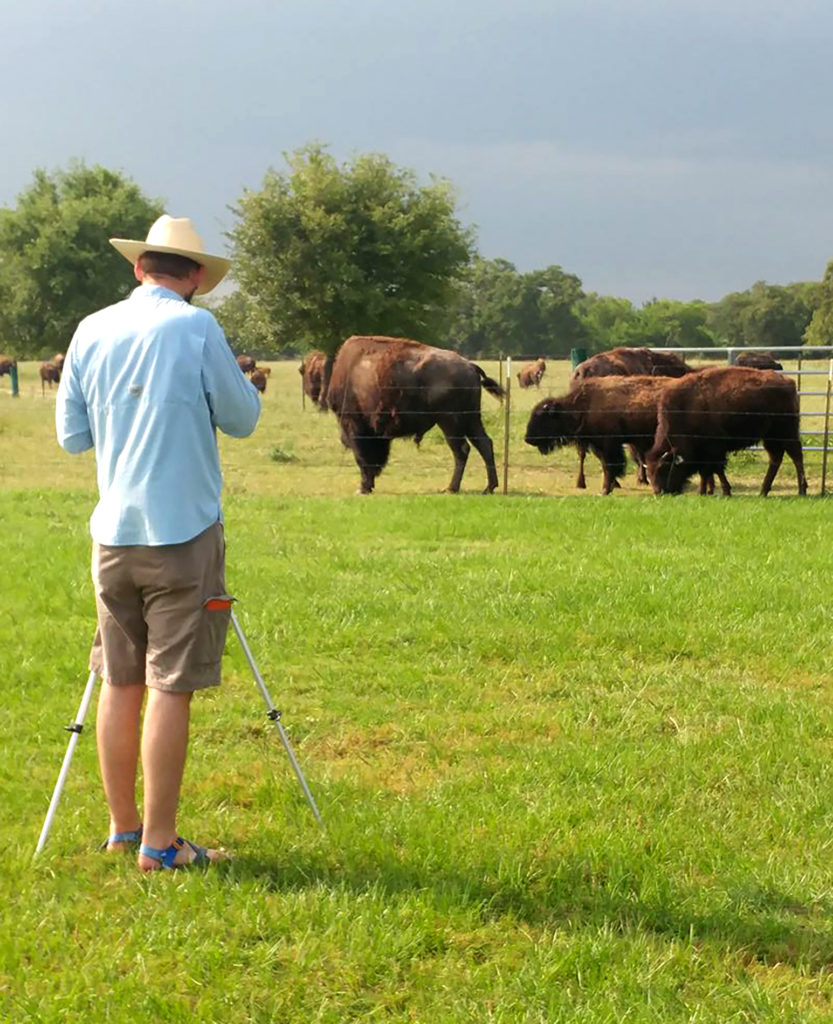Taking the temperature of big game
Graduate students monitor thermoregulation habits, climate impact on moose and bison
Big game are usually resilient and adaptive mammals, but increased warming in productive regions of Alaska and the Great Plains poses a threat to populations of moose and bison.

This comes as no surprise to Jeff Martin, Ph.D., and Dan Thompson, Ph.D., both recent graduates from the Texas A&M College of Agriculture and Life Sciences, who dedicated their doctoral research to examining the effects of warming temperatures on big game.
One component of Martin’s research measured heat flux in bison, while Thompson aimed to understand body temperature regulation in moose.
Understanding how large game respond to rising temperatures provides key insights into the future sustainability of moose and bison populations on landscapes where increased warming has become a concern.
Perry Barboza, Ph.D., a Texas A&M AgriLife Research professor in the Departments of Ecology and Conservation Biology and Rangeland, Wildlife and Fisheries Management, served as Martin and Thompson’s primary mentor for the duration of their program.
“Critical areas of bison habitat and moose habitat are getting hotter and that is affecting the productivity of moose and bison,” Barboza said. “These animals are keystones to their ecology, culturally important and vital to the livelihood of many.”
Factors influencing thermoregulation of moose
Dan Thompson works full-time as a wildlife biologist for the Alaska Department of Fish and Game at the Kenai Moose Research Center, a role he also held while in graduate school.
With support from his employer and Texas A&M’s Boone and Crockett Club, Thompson was able to complete research for his doctoral dissertation, which remotely assessed the thermal tolerance of moose on the Kenai Peninsula and how they regulate body temperature.

Thompson said his study worked off of previous research, which indicated moose exhibit signs of heat stress above a certain ambient temperature. However, he noticed that at ambient temperatures above those thresholds, the captive moose he was working with weren’t exhibiting signs of heat stress indicated in earlier studies. His study aimed to reassess those thresholds and better understand how the moose were actually coping.
“I examined their actual body temperature by placing sensors inside them to determine what their normal ranges are and monitored them to see when they were exceeding those ranges,” Thompson said. “Then, I looked at physiological and behavioral indicators to identify ways they were able to control their body temperature.”
In addition to the body heat sensors, Thompson said he used a variety of technology to monitor the moose’s heart rate, respiration rate, respiration temperature and to collect hormone samples, all to evaluate the animal’s responses to warm environmental conditions.
Contradicting previous findings, Thompson’s results indicate that heat stress thresholds once identified for moose are less rigid than previously reported, suggesting a higher tolerance or resiliency of moose to heat stress.
Additionally, Thompson found that certain behaviors influence moose body temperature during the summer. Surprisingly, Thompson found that moose body temperature decreases during low to moderate activity associated with foraging, which may be a result of ingesting large amounts of cool, wet vegetation.
A warming climate can lead to fires, which affect locations for cooling and forage. Digging deeper, he concluded that factors like intensity and duration of weather, and the capacity of moose to use physiological and behavioral responses, all affect their ability to regulate body temperature. Warm, humid weather can result in prolonged heat loads that reduce feeding and weight gain in moose especially in mid-summer, when they need to gain fat for the following winter.
Drivers of body-size change in bison
Like Thompson, Martin developed his project with support from the Boone and Crockett Club, but also received critical funding from Texas A&M AgriLife Research. Through the National Bison Association, Martin was able to leverage available resources and access a key network of bison managers, with additional support from The Explorers Club and The Mammoth Site.

With a team of support behind him, he hit the open road to conduct novel research in his field. Martin packed up his car and hit the open road alone, traveling a total of 19,000 miles from Texas to Saskatchewan, Canada, to capture heat flux of bison in the summer, and again in the winter.
Using measurements from images of hundreds of animals of multiple ages, Martin was able to record and track the growth of bison from 19 different herds over multiple growing seasons. The results were published in his dissertation, which focused on the drivers and consequences of body size change of bison. Another component of the work compared heat transfers of bison using thermal imaging technology.
“I wanted to test two different mechanisms,” Martin said. “The first being how foraging changes in response to climate and how that affects bison, and the second being how climate affects the animal directly.”
Under heat stress, most animals sweat as a physiological response to reduce heat loads; but bison, like moose, don’t sweat. They have to use a different mechanism.
The thermal imaging technology allowed Martin to measure that change in energy. To collect this data, he used a Forward-Looking Infrared Thermal Imaging Camera, or FLIR, along with a heat stress tracker mobile weather station.
Martin’s data suggested that higher temperatures result in slower growth in bison. In warmer temperatures, bison must work harder to regulate their body temperatures, causing increased stress on the animal, which can result in slower growth rates.
“There’s a threshold somewhere for productive growth that we have yet to identify,” Martin said. “But that’s what I’m trying to work toward.”
Martin said understanding these interactions of bison with their environment will help with conservation and restoring bison to certain areas.
Continuing work for bison, moose conservation
Of all the knowledge they gained in their respective areas of expertise, the pair said their research further instilled in them an appreciation for the resilience of both species.
“Moose are pretty unique,” Thompson said. “In certain conditions, it’s amazing what they can do to adapt and survive.”
“I echo what Dan [Thompson] says,” Martin said. “Bison gain more respect from me every day.”
Martin and Thompson’s research provides evidence which suggests that while the animals are adaptive to change, without recognition of changing conditions, future production of bison and moose in areas with increasing climate variability may not be sustainable.
Martin and Thompson graduated in August with doctoral degrees in Wildlife and Fisheries Sciences. To conduct their research, both received support from AgriLife Research and the Boone and Crockett Club Wildlife and Conservation Policy Program at Texas A&M. Thompson also received the 2019 Boone and Crockett Fellow Outstanding Achievement Award in Graduate Research. Martin was recognized in 2018 as a Rolex Scholar by the Explorers Club.
Barboza said research like Martin and Thompson’s would not exist and could not be successful without the collaborative efforts and support of their primary funders.
“Our goal is to train scientists to lead in conservation and we did that through the help of the Boone and Crockett Club and Texas A&M AgriLife Research,” Barboza said.


